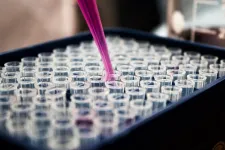The root of SCD is two mutated copies of the hemoglobin gene, HBB, which cause red blood cells to transform from a circular disc into a sickle shape -- setting off a chain of events leading to organ damage, recurrent pain, and early mortality. In this study, the researchers used a molecular technology called base editing to directly convert a single letter of pathogenic DNA into a harmless genetic variant of HBB in human blood-producing cells and in a mouse model of SCD.
"We were able to correct the disease-causing variant in both cell and animal models using a customized base editor, without requiring double-stranded DNA breaks or inserting new segments of DNA into the genome," says co-senior author David Liu, Richard Merkin Professor and director of the Merkin Institute of Transformative Technologies in Healthcare at the Broad Institute, professor at Harvard University, and Howard Hughes Medical Institute investigator. "This was a major team effort, and our hope is that base editing will provide a promising basis for a therapeutic strategy down the road for sickle cell disease."
"Our study illustrates the power and excitement of multidisciplinary collaborations for creating novel mechanism-based cures for genetic diseases," says co-senior author Mitchell Weiss, chair of the St. Jude Department of Hematology. "In particular, we combined expertise in protein engineering, base editing, and red blood cell biology to create a novel approach for treating and possibly curing sickle cell disease."
The work appeared in Nature, led by co-first authors Gregory Newby at the Broad Institute and Jonathan Yen, Kaitly Woodard, and Thiyagaraj Mayuranathan at St. Jude Children's Research Hospital.
An improved approach
Currently, the only established method to cure SCD is a bone marrow transplant -- but finding an appropriate bone marrow donor for a patient is difficult, and patients who undergo a transplant can suffer dangerous side effects. While there are a number of gene editing treatments under development that avoid these risks by modifying a patient's own bone marrow directly, these experimental therapies rely on introducing new DNA or cleaving genomic DNA in cells, which can also cause adverse effects.
For this work, the research team used what's called an "adenine base editor," a molecular tool developed in Liu's lab that can target a specific gene sequence and convert the DNA base pair A* T to G* C, altering a gene at the level of a single pair of nucleotides. The base editor used in this study consists of a laboratory-evolved Cas9 variant -- a CRISPR-associated protein that positions the base editor at the mutated HBB site in the genome -- and a laboratory-evolved enzyme that converts the target A to a base that pairs like G. The base editor also guides the cell to repair the complementary DNA strand, completing the conversion of the target A* T base pair to G* C.
The single DNA mutation underlying sickle cell disease is an A in the healthy hemoglobin gene that has been altered to a T. While an adenine base editor cannot reverse this change, it can convert that T to a C. This edit transforms the dangerous form of hemoglobin into a naturally occurring, non-pathogenic variant called "hemoglobin Makassar."
Editing in models
The team first introduced the adenine base editor into isolated blood stem cells from human SCD patients. In these experiments, up to 80 percent of the pathogenic hemoglobin variants were successfully edited into the benign Makassar variant, with minimal instances of the editor causing undesired changes to hemoglobin.
The researchers transferred these edited blood stem cells into a mouse model to observe how they functioned in live animals. After 16 weeks, the edited cells still produced healthy blood cells.
"Sixteen weeks after transplantation, the total frequency of the edit maintained in stem cells -- which could contain edits in both copies of their hemoglobin gene, in only one copy, or in neither copy -- was 68 percent. And we were particularly excited to see that nearly 90 percent of cells contained at least one edited copy of hemoglobin," explains Newby. "Even those cells with just one edited copy appeared to be protected from sickling."
In a separate set of experiments, the researchers took blood stem cells from mice harboring the human sickle cell disease variant, edited them, and transplanted the edited cells into another set of recipient mice. Control mice transplanted with unedited cells showed typical symptoms: sickled red blood cells, consequences of short red blood cell lifetime, and an enlarged spleen. In contrast, mice transplanted with edited cells were improved compared to controls by every tested disease metric, with all measured blood parameters observed at levels nearly indistinguishable from healthy animals.
Finally, to confirm durable editing of the target blood stem cells, the researchers performed a secondary transplant, taking bone marrow from mice that had received edited cells 16 weeks previously and transferring the blood stem cells into a new set of mice. In the new animal cohort, edited cells continued to perform similarly to healthy blood stem cells, confirming that the effects of base editing were long-lasting. The team determined that editing at least 20 percent of pathogenic hemoglobin genes was sufficient to maintain blood metrics in the mice at healthy levels.
"In these final experimental phases, we demonstrated an editing threshold of about 20 percent that is necessary to mitigate this disease in mice. This base editing strategy is efficient enough to far exceed that benchmark," explains Liu. "The approach offers promise as the basis of a potential one-time treatment, or perhaps even a one-time cure, for sickle cell disease."
The researchers and other partners are working to move this concept safely and effectively into additional preclinical studies, with the eventual goal of reaching patients.
INFORMATION:
About the Broad Institute of MIT and Harvard
Broad Institute of MIT and Harvard was launched in 2004 to empower this generation of creative scientists to transform medicine. The Broad Institute seeks to describe the molecular components of life and their connections; discover the molecular basis of major human diseases; develop effective new approaches to diagnostics and therapeutics; and disseminate discoveries, tools, methods, and data openly to the entire scientific community.
Founded by MIT, Harvard, Harvard-affiliated hospitals, and the visionary Los Angeles philanthropists Eli and Edythe L. Broad, the Broad Institute includes faculty, professional staff and students from throughout the MIT and Harvard biomedical research communities and beyond, with collaborations spanning over a hundred private and public institutions in more than 40 countries worldwide.
About St. Jude Children's Research Hospital
St. Jude Children's Research Hospital is leading the way the world understands, treats and cures childhood cancer and other life-threatening diseases. It is the only National Cancer Institute-designated Comprehensive Cancer Center devoted solely to children. Treatments developed at St. Jude have helped push the overall childhood cancer survival rate from 20% to 80% since the hospital opened more than 50 years ago. St. Jude freely shares the breakthroughs it makes, and every child saved at St. Jude means doctors and scientists worldwide can use that knowledge to save thousands more children. Families never receive a bill from St. Jude for treatment, travel, housing and food -- because all a family should worry about is helping their child live. To learn more, visit stjude.org or follow St. Jude on social media at @stjuderesearch.






